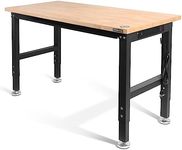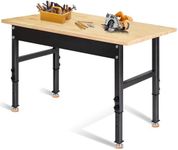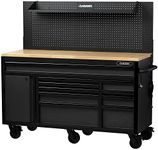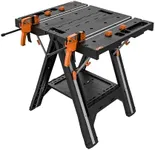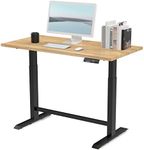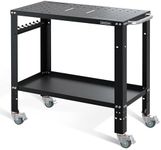Buying Guide for the Best workbenches
Choosing the right workbench is crucial for ensuring that your workspace is efficient, comfortable, and safe. A workbench is a fundamental piece of equipment for any workshop, whether you're a professional craftsman, a DIY enthusiast, or someone who needs a sturdy surface for various projects. When selecting a workbench, consider the type of work you'll be doing, the space you have available, and the specific features that will best support your tasks. Here are some key specifications to consider when choosing a workbench.Size and DimensionsThe size and dimensions of a workbench are important because they determine how much workspace you have and how well the bench will fit in your available space. Workbenches come in various lengths, widths, and heights. For general use, a standard workbench height is around 34-36 inches, which is comfortable for most people. If you have specific needs, such as working on large projects or needing extra storage, you might opt for a larger bench. Measure your workspace and consider the types of projects you'll be working on to choose the right size for you.
MaterialThe material of the workbench affects its durability, weight, and suitability for different tasks. Common materials include wood, metal, and plastic. Wooden workbenches are sturdy and provide a traditional look, making them ideal for woodworking and general use. Metal workbenches are highly durable and can withstand heavy-duty tasks, making them suitable for industrial or mechanical work. Plastic workbenches are lightweight and resistant to chemicals, making them a good choice for environments where spills are common. Consider the type of work you'll be doing and the environment in which you'll be using the bench to choose the best material.
Weight CapacityThe weight capacity of a workbench indicates how much weight it can safely support. This is important to ensure that the bench can handle the tools, materials, and projects you'll be working on without collapsing or becoming unstable. Workbenches with higher weight capacities are typically more robust and suitable for heavy-duty tasks. For light to medium tasks, a workbench with a weight capacity of around 500 pounds may be sufficient. For heavy-duty tasks, look for workbenches that can support 1,000 pounds or more. Assess the weight of the items you'll be using and choose a workbench with an appropriate weight capacity.
Storage OptionsStorage options on a workbench can help keep your workspace organized and efficient. Some workbenches come with built-in drawers, shelves, or pegboards for storing tools and materials. This is particularly useful if you have a lot of small tools or need to keep your workspace tidy. If you require a lot of storage, look for workbenches with multiple drawers or cabinets. If you prefer a more open workspace, a simpler design with fewer storage options might be better. Consider your storage needs and how you like to organize your tools when choosing a workbench.
MobilityMobility refers to how easily you can move the workbench around your workspace. Some workbenches come with wheels or casters, making them easy to move when needed. This can be particularly useful if you have a small workspace or need to frequently reconfigure your setup. If you need a stable, stationary workbench, look for one with adjustable feet or a solid base. If you value flexibility and the ability to move your workbench, choose one with high-quality, lockable casters. Think about how often you'll need to move the bench and choose accordingly.
AdjustabilityAdjustability in a workbench allows you to change the height or configuration to suit different tasks or users. This is important for ensuring ergonomic comfort and versatility. Some workbenches have adjustable legs or tops that can be raised or lowered. This is particularly useful if multiple people will be using the bench or if you need to switch between sitting and standing tasks. If you need a workbench that can adapt to different tasks or users, look for one with adjustable features. Consider how you will use the bench and whether adjustability is important for your comfort and efficiency.
